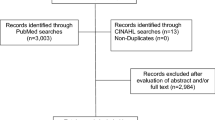Abstract
Objective
Breast cancer is commoner in the affluent and breast cancer rates in many countries are rising; it remains unclear whether this incidence rise is consistent across the different socio-economic groups. The rising incidence of breast cancer may be related to changes in population risk factor profiles. This study aimed to determine breast cancer incidence trends in women of different socio-economic categories and whether these trends were related to breast cancer risk factor trends.
Design
Data on breast cancer incidence rates by deprivation quintile in Scotland 1991–2000 were analysed using linear regression. Data on first births at late maternal age, BMI trends (based on the Scottish Health Surveys) and breast screening uptake trends in the different categories were also analysed and their relation to breast cancer incidence trends explored.
Population and setting
Breast cancer incidence data was based on all women in Scotland. BMI data was based on representative cross-sectional survey data from the Scottish Health Surveys—women in the 1995, 1998 and 2003 surveys were 16–64, 16–74 and aged 16 and over, respectively. First birth data was based on all women aged 35–39 in Scotland. Breast screening uptake data was studied in women of screening age, that is, aged 50–64.
Results
Breast cancer incidence rates in Scottish women are rising in parallel across all socio-economic categories and the incidence gap between deprived and affluent still remains. Since the late 1980s, numbers of first birth in Scottish women aged 35–39 have risen dramatically, especially in the affluent, but numbers were stable before this. The prevalence of obesity and mean BMI has increased over time in all socio-economic classes but BMI continues to be higher in the deprived. Uptake of screening invitations has increased in all socio-economic groups.
Conclusions
Breast cancer is rising in women of all socio-economic status in Scotland and the deprived–affluent gap remains. Trends in late age at first pregnancy, prevalence of obesity and screening uptake do not fully explain the observed trends.



Similar content being viewed by others
References
Dano H, Andersen O, Ewertz M, Petersen JH, Lynge E (2003) Socioeconomic status and breast cancer in Denmark. Int J Epidemiol 32:218–224
Faggiano F, Partanen T, Kogevinas M, Boffetta P (1997) Socioeconomic differences in cancer incidence and mortality. IARC Sci Publ 138:65–176
Ketcham AS, Sindelar WF (1975) Risk factors in breast cancer. Prog Clin Cancer 6:99–114
Pukkala E, Weiderpass E (1999) Time trends in socio-economic differences in incidence rates of cancers of the breast and female genital organs (Finland, 1971–1995). Int J Cancer 81:56–61
Rix BA, Skov T, Lynge E (1997) Socioeconomic group, occupation and incidence of breast cancer and genital cancer among women in Denmark. Eur J Public Health 7:177–181
van Loon AJ, Brug J, Goldbohm RA, van den Brandt PA, Burg J (1995) Differences in cancer incidence and mortality among socio-economic groups. Scand J Soc Med 23:110–120
Keating NL, Cleary PD, Rossi AS, Zaslavsky AM, Ayanian JZ (1999) Use of hormone replacement therapy by postmenopausal women in the United States. Ann Intern Med 130:545–553
Prehn AW, West DW (1998) Evaluating local differences in breast cancer incidence rates: a census-based methodology (United States). Cancer Causes Control 9:511–517
Robbins AS, Brescianini S, Kelsey JL (1997) Regional differences in known risk factors and the higher incidence of breast cancer in San Francisco. J Natl Cancer Inst 89:960–965
Gatrell A, Garnett S, Rigby J, Maddocks A, Kirwan M (1998) Uptake of screening for breast cancer in south Lancashire. Public Health 112:297–301
Scottish Executive Information and Statistics Division (2005) Breast cancer information. http://www.isdscotland.org
Dong W, Erens B (1997) Scottish Health Survey 1995. Edinburgh, The Stationery Office
Bromley C, Sproston K, Shelton N (2005) Scottish Health Survey 2003. Edinburgh, The Stationery Office
Shaw A, McMunn A, Field J (2000) Scottish Health Survey 1998. Edinburgh, The Stationery Office
Scottish Executive Information, Statistics Division (2005) Breast Screening Data. http://www.isdscotland.org
Brown J, Harding S, Bethune A, Rosato M (1997) Incidence of health of the nation cancers by social class. Popul Trends 90:40–48
Wrensch M, Chew T, Farren G, Barlow J, Belli F, Clarke C et al (2003) Risk factors for breast cancer in a population with high incidence rates. Breast Cancer Res 5:R88–R102
CDC (2005) Breast cancer screening and socioeconomic status—35 metropolitan areas, 2000 and 2002. MMWR 54:981–985
Pathak DR, Whittemore AS (1992) Combined effects of body size, parity, and menstrual events on breast cancer incidence in seven countries. Am J Epidemiol 135:153–168
Pathak DR, Osuch JR, He J (2000) Breast carcinoma etiology: current knowledge and new insights into the effects of reproductive and hormonal risk factors in black and white populations. Cancer 88:1230–1238
Rosner B, Colditz GA, Willett WC (1994) Reproductive risk factors in a prospective study of breast cancer: the Nurses’ Health Study. Am J Epidemiol 139:819–835
van den Brandt PA, Spiegelman D, Yaun SS, Adami HO, Beeson L, Folsom AR et al (2000) Pooled analysis of prospective cohort studies on height, weight, and breast cancer risk. Am J Epidemiol 152:514–527
Schouten LJ, de Rijke JM, Huveneers JA, Verbeek AL (2002) Rising incidence of breast cancer after completion of the first prevalent round of the breast cancer screening programme. J Med Screen 9:120–124
Author information
Authors and Affiliations
Corresponding author
Rights and permissions
About this article
Cite this article
Brown, S.B.F., Hole, D.J. & Cooke, T.G. Breast cancer incidence trends in deprived and affluent Scottish women. Breast Cancer Res Treat 103, 233–238 (2007). https://doi.org/10.1007/s10549-006-9361-2
Received:
Accepted:
Published:
Issue Date:
DOI: https://doi.org/10.1007/s10549-006-9361-2




